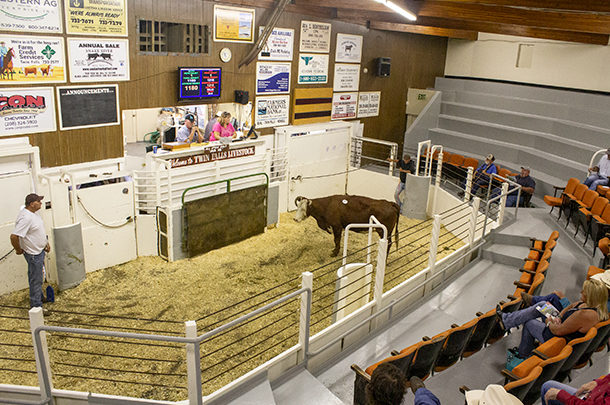The short-term feeding of grain-based diets to cull cows can represent an opportunity for both cow-calf producers and finishing operations. For cow-calf producers, feeding cull cows represents a chance to increase the value of an asset that typically represents 15% to 30% of their yearly gross revenues. For finishing operations, it can represent a profitable cattle-feeding opportunity at certain times of the year.
The economic incentives for feeding cull cows include a potentially favorable cost of gain in thin cows, altering fat color to receive the white fat premium, upgrading the marketing class of the cows and moving the sale date of cows to a more favorable market.
Cows are often culled due to drought, lack of available feed resources to maintain them through the fall and winter or lack of reproductive performance. Cattle that have been on a low plane of nutrition have relatively low gastrointestinal tract and liver weights. These tissues are very energetically expensive to maintain and represent a large portion of the animal’s daily maintenance energy requirements.
Therefore, thin cattle are very efficient at putting on weight because more of the energy they consume is available to support gain. Strategies that increase energy consumption of cull cows without causing digestive issues are very beneficial to the cull cow feeder. Additionally, all cull cows should receive a combination hormone implant that contains 200 milligrams of trenbolone acetate and 20 milligrams of estradiol (or 28 milligrams of estradiol benzoate) to maximize efficiency.
Cull cow feeding challenges
Cows that are on a forage diet will typically produce a carcass with yellow fat due to the beta carotene present in most forages. When fed a diet low in beta carotene, the fat of the animal will begin to turn white. Given sufficient time, a cow fed a diet high in cereal grains and other concentrates may qualify as a premium, white fat cow.
The number of days cows should be fed to sufficiently alter fat color is based on several factors. The first factor is amount of dietary beta carotene fed during the feeding period. Feeding higher roughage step-up rations for long periods of time will delay the change in fat color. Another factor is the initial concentration of beta carotene in the fat of the animal. Cattle that were fed growing forages will have a greater concentration of beta carotene in their fat. The half-life of beta carotene is 30 days, which means 50% of the beta carotene is metabolized every 30 days.
The carcasses of mature cows are available for the USDA quality grades of Commercial, Utility, Cutter and Canner. However, most cull cows are not graded but are categorized by the terms used by the USDA Agricultural Marketing Service (AMS) when reporting prices of cows sold at auction. Fed cows generally fall into one of four categories (in decreasing order of desirability): breaking, boning, leans or lights, which generally correspond to the cow’s level of fatness.
The fatter cows (i.e., breaking) are given a premium because they will generally dress better than thin cows (i.e., leans and lights) and they may be processed into retail cuts destined for specific markets. The only way to increase the fatness of a cow is to increase her energy intake either by feeding her longer or by increasing the energy density of the diet.
The final and perhaps largest economic incentive to feeding cull cows is moving their marketing date to a more favorable time of the year. Most producers sell their cull cows in late fall and early winter following pregnancy checks. This leads to the bottom of the cull cow market typically being in November and December, correlating with the greatest supply. USDA AMS data from 2015 to 2020 shows that, on average, the cull cow price jumps $10.34 per hundredweight (cwt) from December to January.
The price then continues to climb by an average of $1.31 per cwt every month until it reaches its peak in July. By retaining or purchasing cull cows late in the year and feeding them until sometime in the first quarter of the next year, producers are improving the price they will receive and increasing the amount of weight they will sell.
Profit opportunities
Tied into this entire discussion is a desire to increase concentrate intake and reduce roughage intake of cows during the short-duration feeding period. This will increase overall energy intake and reduce the amount of beta carotene in the diet, allowing a producer to fully take advantage of:
- Early period compensatory gain
- Rapid fat color change
- Upgraded cow class
- Maximized salable weight in a favorable market
Typically, cattle must be transitioned slowly to a high-concentrate diet or they will experience a rapid reduction in rumen pH due to organic acid accumulation. Lactic acid is the primary acid that accumulates in the rumen when naive cattle are given high levels of concentrates, leading to acidosis.
One management tool available to regulate rumen pH is Megasphaera elsdenii. This is a bacterium that consumes lactic acid as its preferred energy source in the rumen. Researchers at Texas Tech University evaluated the use of Megasphaera elsdenii in thin cull cows rapidly stepped up onto a finishing diet in 10 days. Cows given the bacterium at the beginning of the trial had 10% greater average daily gain (ADG) over the 42-day experiment.
In another experiment, the same researchers demonstrated that thin cows given Megasphaera elsdenii at trial initiation had greater ruminal absorptive area at the end of the 35-day experiment, indicating better rumen health and nutrient absorption. This observation is attributed to the production of a short-chain fatty acid called butyrate by Megasphaera elsdenii. Butyrate is used by the rumen as an energy source and increases development of finger-like projections called papillae that line the rumen.
Under the guidance of a qualified nutritionist and with proper bunk space and management, the use of Megasphaera elsdenii to transition cows more quickly to their final diet is an opportunity for any producer looking to maximize the revenue of their fed cull cows.











